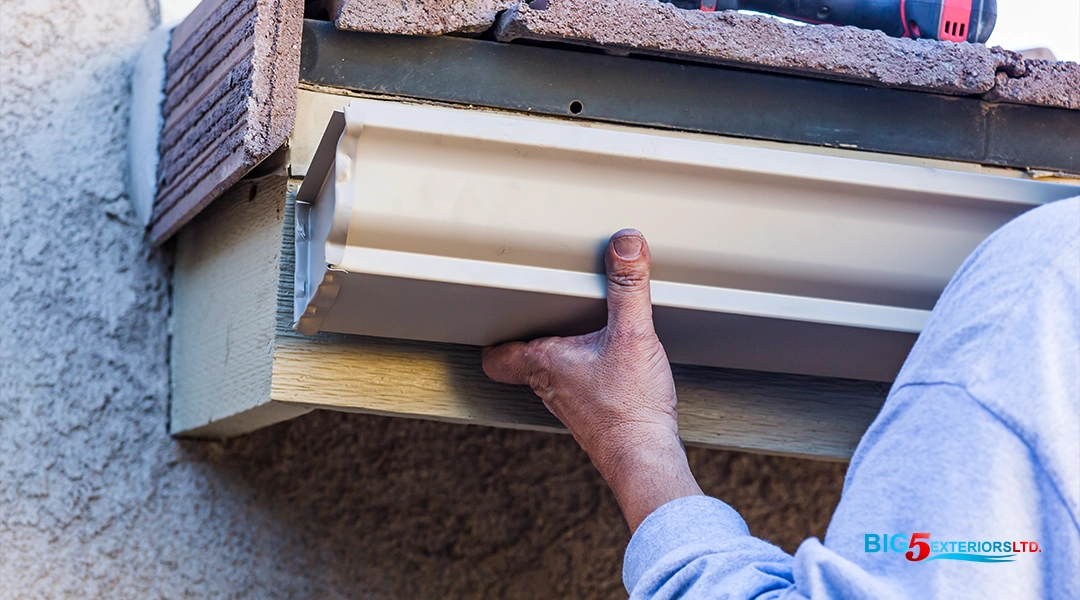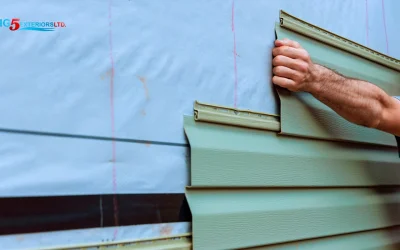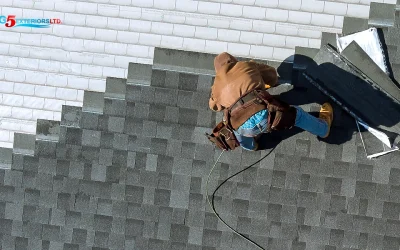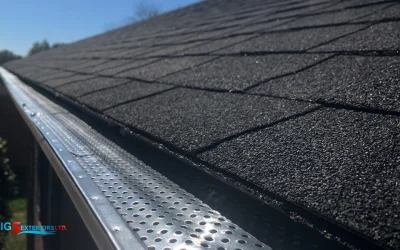Summary:
- Properly measuring gutters helps prevent issues like water overflow and erosion.
- Essential tools for measuring gutters include a tape measure, ladder, notepad and pen, safety gear, and a level.
- You’ll need to measure the troughs (including shape and size), downspouts (length and width), and gutter slope using a level. Document these measurements for future reference.
- Use your recorded measurements to calculate gutter capacity and select the appropriate size and type of gutter (K-style or half-round) for your home, taking into account the area’s maximum rainfall intensity and the roof size.
- To have your gutters measured by a professional and ensure you’re installing the right size, contact Big 5 Exteriors.
Gutters channel rainwater away from your home, protecting the foundation, walls, and landscaping from water damage. But improperly sized gutters can lead to water overflow, basement flooding, and erosion around the house.
If you are replacing your gutters, experiencing water-related issues, or building a new home, you need to make sure your gutters are adequately sized to handle the volume of water typical for your area. Below, we’ll show you how and what you’ll need.
See Also: Sure Signs You Need to Replace Your Eavestroughs

Required Tools for Measuring Gutters
Here’s what you’ll need.
- Tape Measure: Essential for taking accurate linear measurements.
- Ladder: To safely access the gutters.
- Notepad and Pen: For recording measurements.
- Safety Gear: Including gloves, non-slip shoes, and safety glasses.
- Level: To check the gutter’s slope.
For tips on how to use these tools as safely as possible, see the FAQ at the end of this post.
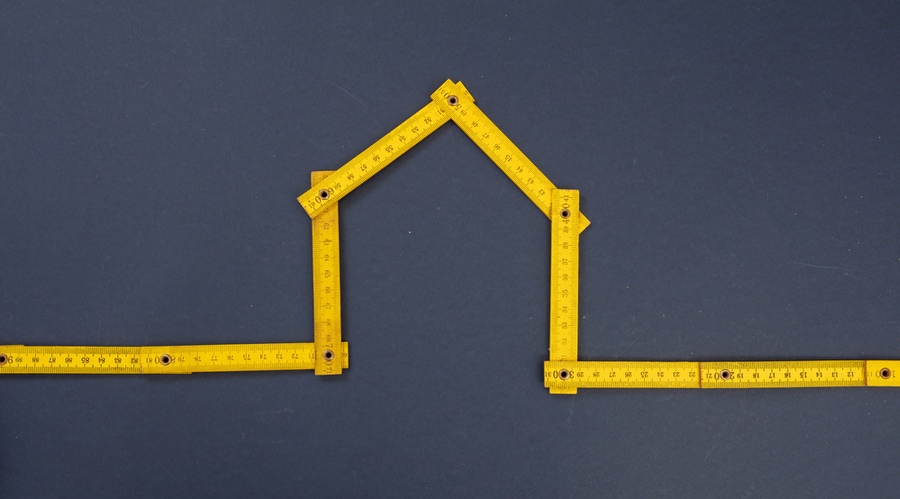
Step-by-Step Measurement Process
Here’s how to measure your gutters—even if you’ve never done it before. These measurements will help you determine the volume of water the gutter can handle, and prevent you from installing a shallow or narrow gutter that may overflow in heavy rain.
1. Measuring the Trough
- Identifying Shape and Size: Note if the gutters are half-round, K-style, or another shape. The shape influences how quickly water flows and how much debris they can collect.
- Length Measurement: Using the tape measure, extend it from one end of the gutter to the other along the roofline. Record this measurement for each section.
- Width Measurement: Measure the gutter from the back (where it’s attached to the roof) to the front lip.
- Depth Measurement: Measure from the bottom of the gutter to the top of the front edge.
2. Finding Your Downspout’s Dimensions
- Measuring Length: Measure the height of each downspout from where it starts at the gutter to where it ends near the ground.
- Measuring Width: Measure the width or diameter of the downspout to ensure it’s large enough to handle the water flow from the gutters.
3. Evaluating the Gutter Slope
- Using a Level: Place a level against the bottom of the gutter. There should be a slight slope towards each downspout.
- Checking Slope: For every 10 feet of gutter, there should be about a quarter inch of slope towards the downspout. Adjust your measurements to account for this.
4. Documenting Your Measurements
- Record Keeping: Write down each measurement, labeling them clearly (e.g., “Front Gutter Length,” “Left Downspout Width”).
- Taking Notes on Condition: Note any sections that are damaged or worn out, as these may need more attention or replacement.

Using Recorded Measurements to Determine Gutter Size
After recording the measurements of your gutters and downspouts, the next step is to use these measurements to determine the appropriate size for your home’s gutters. Here’s how to do it:
Calculating Gutter Capacity
First, use the width and depth measurements to calculate the cross-sectional area of your gutters. For example, if your gutter is 5 inches wide and 4 inches deep, its area is 20 square inches.
Next, consider the maximum rainfall intensity for your region. This information can usually be found through local building codes or weather services. For example, if the maximum rainfall intensity is 6 inches per hour, you need a gutter system that can handle this volume.
See Also: What Water Does When it Sits at the Base of Your Foundation (& How Your Eavestrough Can Help)
Matching Gutter Type & Size
- K-Style Gutters: These are the most common in residential homes. A 5-inch K-style gutter is typically sufficient for moderate rainfall areas. For a home with a 2,000 square foot roof in an area with heavy rainfall, a 6-inch K-style gutter may be more appropriate.
- Half-Round Gutters: These are typically found on older or historic homes. A 5-inch half-round gutter can handle approximately the same amount of water as a 4-inch K-style gutter. So, if your measurements suggest that a 4-inch K-style gutter is adequate, you would need a 5-inch half-round gutter for the same performance.
Determining the Correct Downspout Size
A standard rule is that a single square inch of downspout can drain 1,200 square feet of roof area in an area with moderate rainfall.
For instance, if your roof is 2,400 square feet, you would need downspouts totaling at least 2 square inches in cross-sectional area.
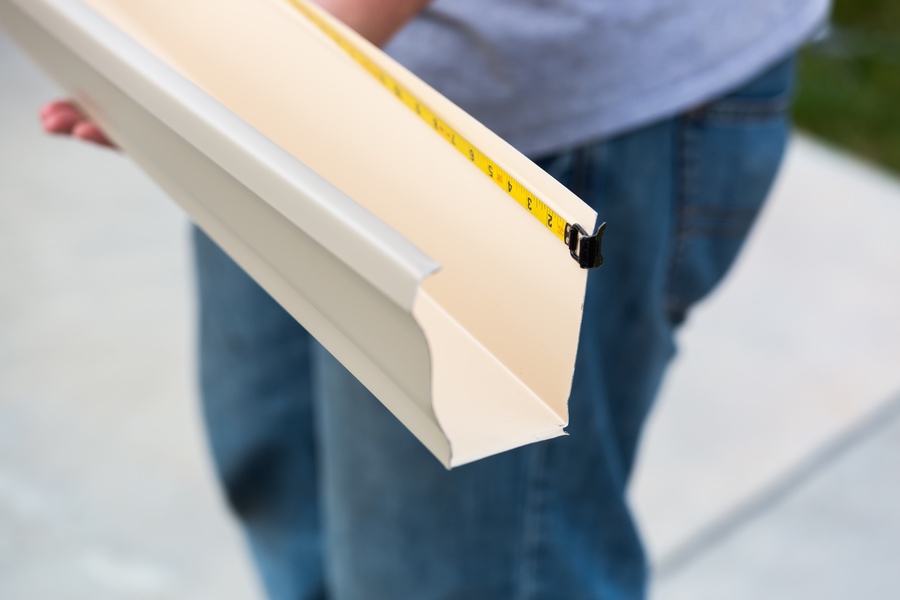
How Gutter Size Impacts Home Maintenance
Choosing the right gutter size for your home protects it in a number of vital ways. These include:
- Preventing water damage to your home’s foundation, basement, and exterior walls.
- Reducing the risk of overflow during heavy rains, as well as clogging by leaves and debris.
- Preventing water backup under roof shingles, which can cause leaks and damage to the roof structure.
- Enhancing the overall appearance of your home and potentially contributing to its market value.
- Reducing the need for emergency maintenance, repairs, or premature replacements, which saves you money in the long run.
Consulting with our home exterior professionals is the best way to get new gutters designed for your home’s needs. Contact Big 5 for personalized recommendations that will ensure your roof’s drainage system is always functioning properly.
Frequently Asked Questions about Measuring Gutter Size
What should you do to make sure you’re measuring your gutters safely?
- Position the ladder on a stable, level surface. Ensure it extends at least three feet over the edge of the roof for stability.
- Wear non-slip shoes to prevent slipping, gloves to protect your hands, and safety glasses to shield your eyes from debris.
- Climb the ladder carefully, maintaining three points of contact (two hands and one foot, or two feet and one hand) at all times.
What are the most important parts of your gutter system?
- The Trough: This is the horizontal section attached to the edge of the roof. It collects rainwater from the roof.
- Downspouts: These are vertical pipes that carry water from the trough to the ground or drainage system.
- End Caps: Found at the ends of the trough, these stop water from spilling out.
How far apart should gutter hangers be?
Gutter hangers should be close enough to prevent sagging (typically 24-36 inches apart).
How can I measure my gutter size more accurately?
- Use a Digital Measuring Tool: For more accuracy, consider using a digital measuring tool, especially for hard-to-reach areas.
- Check for Sagging: Before measuring, ensure the gutters are not sagging. Sagging can impact the true length and slope measurements.
- Measure During Dry Weather: Wet conditions can affect the accuracy of your tape measure, especially if it’s a metal one prone to expansion.
- Avoid Guesswork: If you can’t reach a certain part of the gutter safely, don’t guess the measurement. Instead, seek help from our pros.

